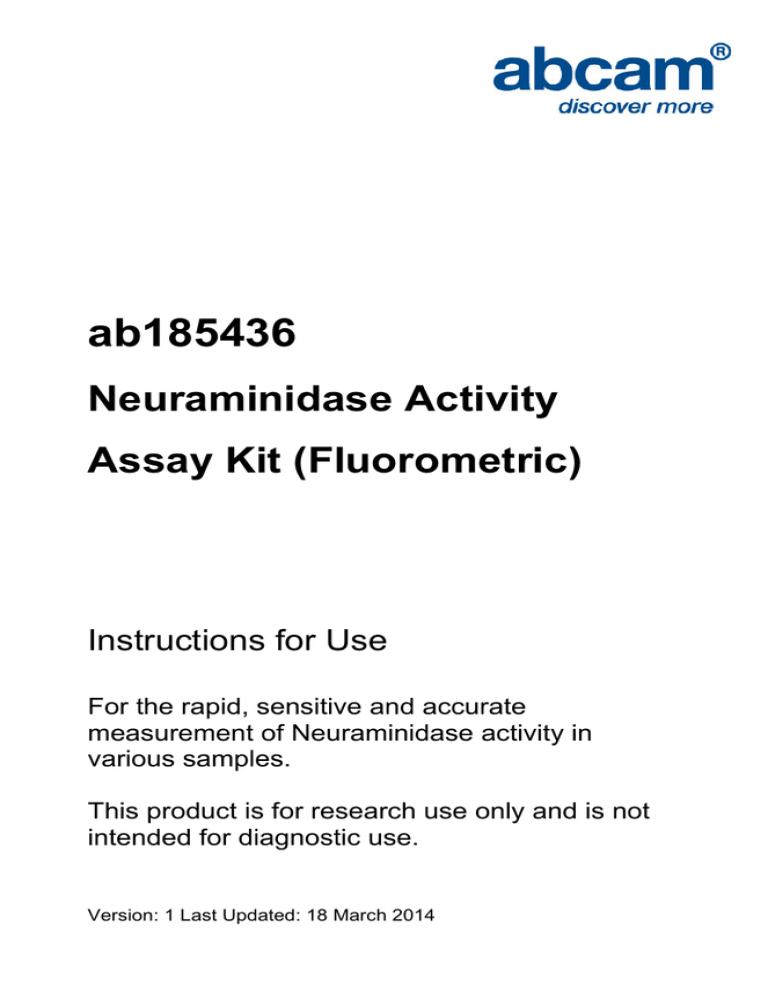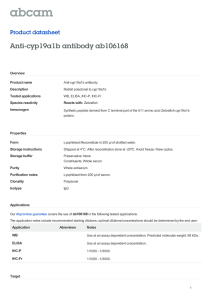
ab185436
Neuraminidase Activity
Assay Kit (Fluorometric)
Instructions for Use
For the rapid, sensitive and accurate
measurement of Neuraminidase activity in
various samples.
This product is for research use only and is not
intended for diagnostic use.
Version: 1 Last Updated: 18 March 2014
1
Table of Contents
1.
Overview
3
2.
Protocol Summary
4
3.
Kits Components
5
4.
Storage and Stability
6
5.
Materials Required, Not Supplied
6
6.
Reagents Preparation
7
7.
Assay Protocol
8
8.
Data Analysis
11
9.
Troubleshooting
15
2
1. Overview
Neuraminidase (NA) is a very common enzyme that hydrolyzes
terminal sialic acid residues on polysaccharide chains; most often a
galactose residue. NA activity plays a key role in the invasion of
target cells and the replication of influenza virus. NA activity also
assists in the elution of progeny viruses from infected cells, and
prevents self-aggregation of virus. Thus, NA is an important target
for drug development.
Abcam's
Neuraminidase
Activity
Assay
Kit
(Fluorometric)
(ab185436) provides a simple and sensitive method for measuring
NA activity using fluorescence (Ex/Em = 530/590 nm). The assay
utilizes NA Probe to detect the neuraminidase activity. This highthroughput adaptable assay kit can detect NA activity as low as
2.0 mU/ml
in
a
variety
of
samples.
3
2. Protocol Summary
Reagent Preparation
Standard Curve Preparation
Control and Samples Preparation
Reaction
Measure Fluorescence and Calculation
4
3. Kits Components
Item
Quantity
NA Assay Buffer
30 mL
NA Probe
200 µL
NA Enzyme Mix I
1 vial
NA Enzyme Mix II
1 vial
Galactose Standard (100 nmol/µL)
100 µL
NA Positive Control
100 µL
NA Substrate
1 vial
5
4. Storage and Stability
Upon arrival, store the kit at-20°C and protect from light. Please read
the entire protocol before performing the assay. Avoid repeated
freeze/thaw cycles.
Briefly centrifuge all small vials prior to opening.
5. Materials Required, Not Supplied
Distilled water (dH2O)
96-well black plate with flat bottom
Multi-well spectrophotometer (ELISA reader)
6
6. Reagents Preparation
1. NA Assay Buffer and NA Probe:
Warm to room temperature before use. Aliquot and store at
-20°C. Stable for two months.
2. NA Substrate:
Reconstitute with 110 µL dH2O. Aliquot and store at -20°C.
Stable for two months.
3. NA Positive Control:
Aliquot and store at -20°C. Use within two months
4. NA Enzyme Mix I and Enzyme Mix II:
Reconstitute with 220 µL NA Assay Buffer. Aliquot and store
at -20°C. Stable for two months.
7
7. Assay Protocol
1. Sample Preparation
a) Homogenize 10 mg of sample (wet weight or cell pellet) in
100 µL NA Assay Buffer.
b) Centrifuge at 10,000 x g for 5 minutes at 4°C. Collect the
supernatant.
c) Add 2-10 µL of supernatant or serum into a 96-well plate and
adjust the volume to 50 µL with NA Assay Buffer.
d) Add 10 µL of NA Positive Control into desired wells(s) and adjust
the
volume
to
50
µL
with
NA
Assay
Buffer.
NOTE:
For
unknown
samples,
we
suggest
performing
pilot
experiment & testing several doses of your samples to
ensure the readings are within the Standard Curve range.
For samples having background, prepare parallel well(s)
containing the same amount of sample as in the test well
(sample background control). Adjust the volume to 50 µL with
NA Assay Buffer.
1% or higher Triton X-100 concentration interferes with the
assay.
8
2. Standard Curve Preparation:
a) Dilute Galactose Standard to 1 nmol/µL by adding 10 µL of
100 nmol/µL Galactose Standard into 990 µL of NA Assay
Buffer, mix well. Dilute the Standard further to 0.1 nmol/µL by
adding 20 µL of 1 nmol/µL Standard to 180 µL of NA Assay
Buffer and mix.
b) Add 0, 1, 2, 3, 4 and 5 µL of 0.1 nmol/µL Galactose Standard
into a series of wells in 96-well plate to generate 0, 0.1, 0.2, 0.3,
0.4 and 0.5 nmol/well of Galactose Standard.
c) Adjust the volume to 50 µL/well with NA Assay Buffer.
3. Reaction Mix:
Prepare enough Reaction Mix for the number of assays to be
performed. For each well, prepare 50 µL Mix containing:
Reaction Mix
Background
Control Mix
NA Assay Buffer
44.5 µL
45.5 µL
NA Enzyme Mix I
2 µL
2 µL
NA Enzyme Mix II
2 µL
2 µL
NA Substrate
1 µL
-----
0.5 µL
0.5 µL
NA Probe
9
Add 50 µL of Reaction Mix to each well containing the Standards,
Positive Control and samples. Mix well.
* For samples having background, add 50 µL of Background
Control Mix to sample background control well(s). Mix well.
4. Measurement
Incubate for 30 minutes at 37°C and measure fluorescence
(Ex/Em = 535/590 nm) kinetically.
NOTE:
Incubation time depends on the NA Activity in the samples.
Choose two time points (T1 and T2) in the linear range
(fluorescence values A1 and A2 respectively) to calculate the
NA activity of the samples. The Standard Curve can be read
in end point mode (i.e. at the end of incubation time).
10
8. Data Analysis
Calculations:
a) Subtract 0 Standard reading from all readings. Plot the
Galactose Standard Curve. If sample background control
reading is significant, subtract background control reading from
sample readings. Calculate the NA activity of the test sample:
ΔRFU = A2 – A1. Apply ΔRFU to the Standard Curve to get
B nmol of Galactose generated by NA during the reaction time
(ΔT = T2 – T1).
Sample Neuraminidase Activity = B/(ΔT X V) x D = nmol/min/ml
= mU/ml
Where:
B is the Galactose amount from the Standard Curve (nmol)
ΔT is the reaction time (minutes)
V is the sample volume added into the reaction well (mL)
D is the sample dilution factor
Unit Definition: One unit of Neuraminidase activity is the
amount of enzyme that generates 1.0 µmol of Galactose per
min. at pH 7.4 at 37°C.
11
Figure 1. Galactose Standard Curve.
12
Figure 2. NA activity in normal Human serum (1 µL) and positive
control (1 µL). Assays were performed following the kit protocol.
13
Figure 3. Calculated activity of serum. Assays were performed
following the kit protocol.
14
9. Troubleshooting
Problem
Reason
Solution
Assay not
working
Assay buffer at
wrong temperature
Assay buffer must not be chilled
- needs to be at RT
Protocol step missed
Plate read at
incorrect wavelength
Unsuitable microtiter
plate for assay
Unexpected
results
Re-read and follow the protocol
exactly
Ensure you are using
appropriate reader and filter
settings (refer to datasheet)
Fluorescence: Black plates
(clear bottoms);
Luminescence: White plates;
Colorimetry: Clear plates.
If critical, datasheet will indicate
whether to use flat- or U-shaped
wells
Measured at wrong
wavelength
Use appropriate reader and filter
settings described in datasheet
Samples contain
impeding substances
Unsuitable sample
type
Sample readings are
outside linear range
Troubleshoot and also consider
deproteinizing samples
Use recommended samples
types as listed on the datasheet
Concentrate/ dilute samples to
be in linear range
15
Problem
Reason
Solution
Samples
with
inconsistent
readings
Unsuitable sample
type
Refer to datasheet for details
about incompatible samples
Use the assay buffer provided
(or refer to datasheet for
instructions)
Samples prepared in
the wrong buffer
Samples not
deproteinized (if
indicated on
datasheet)
Cell/ tissue samples
not sufficiently
homogenized
Too many freezethaw cycles
Samples contain
impeding substances
Samples are too old
or incorrectly stored
Lower/
Higher
readings in
samples
and
standards
Not fully thawed kit
components
Out-of-date kit or
incorrectly stored
reagents
Reagents sitting for
extended periods on
ice
Incorrect incubation
time/ temperature
Incorrect amounts
used
Use the 10kDa spin column
(ab93349)
Increase sonication time/
number of strokes with the
Dounce homogenizer
Aliquot samples to reduce the
number of freeze-thaw cycles
Troubleshoot and also consider
deproteinizing samples
Use freshly made samples and
store at recommended
temperature until use
Wait for components to thaw
completely and gently mix prior
use
Always check expiry date and
store kit components as
recommended on the datasheet
Try to prepare a fresh reaction
mix prior to each use
Refer to datasheet for
recommended incubation time
and/ or temperature
Check pipette is calibrated
correctly (always use smallest
volume pipette that can pipette
entire volume)
16
Problem
Reason
Solution
Standard
curve is not
linear
Not fully thawed kit
components
Wait for components to thaw
completely and gently mix prior
use
Pipetting errors when
setting up the
standard curve
Incorrect pipetting
when preparing the
reaction mix
Air bubbles in wells
Concentration of
standard stock
incorrect
Errors in standard
curve calculations
Use of other
reagents than those
provided with the kit
Try not to pipette too small
volumes
Always prepare a master mix
Air bubbles will interfere with
readings; try to avoid producing
air bubbles and always remove
bubbles prior to reading plates
Recheck datasheet for
recommended concentrations of
standard stocks
Refer to datasheet and re-check
the calculations
Use fresh components from the
same kit
17
18
UK, EU and ROW
Email: technical@abcam.com | Tel: +44(0)1223-696000
Austria
Email: wissenschaftlicherdienst@abcam.com | Tel: 019-288-259
France
Email: supportscientifique@abcam.com | Tel: 01-46-94-62-96
Germany
Email: wissenschaftlicherdienst@abcam.com | Tel: 030-896-779-154
Spain
Email: soportecientifico@abcam.com | Tel: 911-146-554
Switzerland
Email: technical@abcam.com
Tel (Deutsch): 0435-016-424 | Tel (Français): 0615-000-530
US and Latin America
Email: us.technical@abcam.com | Tel: 888-77-ABCAM (22226)
Canada
Email: ca.technical@abcam.com | Tel: 877-749-8807
China and Asia Pacific
Email: hk.technical@abcam.com | Tel: 108008523689 (中國聯通)
Japan
Email: technical@abcam.co.jp | Tel: +81-(0)3-6231-0940
www.abcam.com | www.abcam.cn | www.abcam.co.jp
Copyright © 2013 Abcam, All Rights Reserved. The Abcam logo is a registered trademark.
All information / detail is correct at time of going to print.
19
Copyright © 2013 Abcam, All Rights Reserved. The Abcam logo is a registered trademark.
All information / detail is correct at time of going to print.

